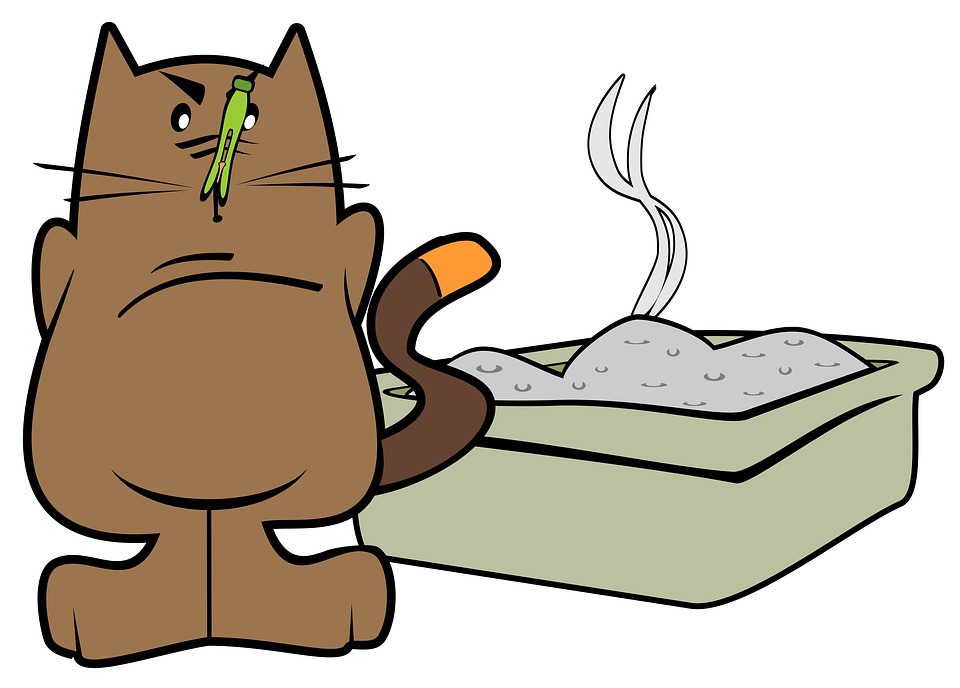Ultimate Litter Box Guide by Purrdy Paws
Posted by Purrdy Paws on Jan 1st 2018

We love cats here at Purrdy Paws. Cats self groom & groom you ! They also are fastidious in their litter box habits. Keeping your cat's litter box clean, to their standards, is incredibly vital. We want to help you to keep your cat from "thinking outside the box."
There are four vital components of proper litter box care for your Purrdy Paws Kitty:
- Set up
- Boxes and Litter
- Cleaning
- Training
Set up
How many litter boxes do you need?
The general rule of purrdy paw is one litter box for every cat within the home, plus one more. This ensures that you will always have clean litter for your kitty, and will let them use the rest room even when you are cleaning up one box. Place at least one litter box on every floor of your house
Where to place your litter boxes?
It's usually not possible to designate a private litter box for every cat in your family, as cats might use any litter box that is accessible. Even if you put name tags up on the boxes, we have found most cats ignore this!
- Sharing Boxes
- Cats sometimes refuse to use a litter box once another cat has been in it. During these cases, you'll have to maintain cleanliness in all of the litter boxes, and you may consider further boxes.
- Multiple boxes in one location can result in your cats considering them as a massive box and ambush other cats when they are using the boxes. Always spread your boxes around
- Avoid Placing Boxes in Remote Areas
- You may think that placing a litter box in a remote area, like the basement, is for the best. It can minimize odors and you wouldn't have to worry about litter trails after usage. However we at Purrdy Paws have found that these areas can be naturally forgotten about, and cleaning happen less often than it should. Your cat may just not use it as its inconvenient. It also distances your cat from your you - and we always want our cat's company !
- Take Care next to Appliances
- Washers, Driers, ovens, and furnaces all make noises which may make a cat nervous
- Heat from a appliance or chamber will enlarge the litter box smell, unpleasant for you and your cat may stop using the box
- Distance from Food and Water
- Put the box away from their food and water bowls.
- Placement in rooms that may be closed
- If you place the litter box in a room, such as a closet or a toilet, which may become closed, make certain there are multiple access points so your cat doesn't become cornered within or prevented from entering out. You may need to add pet doors to ensure your cat's ability to use the box
Purrdy Paws recommends that you place multiple litter boxes throughout your home in open, easy to access locations
Shop Cat Goodies now at Purrdy Paws
Boxes & litter
Covered boxes
Covered boxes will increase privacy and reduce the quantity of litter that flies from the box as your cat buries their business, but there are some potential downsides. Cleaning covered boxes are usually easy to dump entirely, but care must also be taken in periodically cleaning the entire box and changing any filters to avoid odors. Covered boxes may also be troublesome for larger cats to position themselves in. If you have multiple cats, they may ambush each other as they are leaving the boxes
Self-cleaning boxes
There are a number of self cleaning litter boxes on the market. These promise convenience, so that the box is more clean if you cannot always attend to it.
Consumers beware: a number of these options might stop a cat from needing to use their litter box. Your kitty may be scared of the mechanism. Cats raised with tradional boxes tend to not acclimate well to self cleaning boxes. Self cleaning boxes are a tool, you always need to take the final responsibility to keep the box clean.
Open litter boxes
Open boxes are sometime avoided because people don't want to see the end result, and sometimes because people believe they create odors.
Litter must be continuously cleaned up, and its best to know that it's time to clean and just do it !
The best open litter boxes offer high enough side walls to avoid accidental litter sprays and spills. They also need to be easily entered by your kitty.
Types of litter
There are many differing kinds of cat litter on the market. Litters types include clay, scooping/clumping litter, crystal-based/silica gel litter and plant-derived/biodegradable litter.
Most cats like fine-grained litters, as a result of they need a softer feel.
Newer scoopable and “clumping” litter have finer grains than typical clay litter and are extremely popular as a result. They usually do a great job in keeping down the odor.
High-quality, dust-free clay litters are fairly powdered and should be utterly acceptable to your cat.
Once you discover a litter your cat likes, follow it! Avoid changes in litter types that can cause disruptions to your cat's routine and accidents.
We have found that outdoors cats who are used to dirt, can start using your houseplants as litter boxes - yuck ! You may need to mix dirt in with your litter to lure your cat back to the litter box. You may also need to use sand, rather than litter.
Avoid adding scents or sprays to litter. Baking soda is a safe way to minimize odors, but anything else can cause your cat to avoid their box, and may even cause allergies.
Purrdy Paws recommends open litter boxes and using a consistent litter that works for both you and your pet
Cleaning
Scooping
To take care of your awesome cat, no matter what litter box and litter you choose - you must scoop all litter boxes daily.
Replacing litter does depend on the type of litter. Purrdy Paws recommends referencing the manufacturer for exact details.

General guidelines:
- Regular Clay: this litter does not clump and so should be tossed away entirely when it is soiled. This can be daily, weekly or twice weekly depending on your circumstances.
- Scoopable Clay: these litters should be scooped daily and changed out monthly
- Silica: These natural absorbent litters should be scooped for solid waste and totally changed out monthly.
- Wheat, Corn and Pine: These should be scooped free of solid waste daily and changed out totally at least monthly.
If you notice an odor or if much of the litter is wet or clumped, it's time for a change.
Box Cleaning
Scrub the box every time you change the litter. Use mild dish detergent to clean it, as products with ammonia or citrus oils can turn a cat off, and some cleaning products are toxic to cats.
Liner notes
Box liners are strictly a convenience for the owner. Liner are used like a garbage bag to pick up all the litter at once. However, the reality is that the majority cats shred liners to bits when scratching within the box. If a liner works for your cat, they are a great time saver, and if they don't you cannot force your cat to change to use them.
Depth of litter
Most cats will not use litter that is over 2 inches deep. In fact, some cats really like even less litter and feeling the hard surface of the box. Adding additional litter isn't a work around for scooping and cleaning less often - you always have to do that.
Purrdy Paws recommends consistent daily scooping complimented by a regular routine of litter replacement and litter box scrubs
Shop for Great Cat Product Now at Purrdy Paws
Training
Most cats learn from their mothers at a very young age to use a litter box, but recently-adopted stray or feral cats may not know how to use a litter box. If you need to help your kitty in their litter box usage, following some simple tips will help get your cat on the right path.
Sometimes even a well-trained cat may seem to "forget" and start relieving himself around the house. The reasons for this lapse in litter box training may vary from medical issues to simple tastes and preferences.
- Punishment isn't the solution, neither is banishing your cat outdoors.
- Learn your cat's schedule - for example if your cat relieves themselves after a play session, take time to bring them near the box after you play with them
- Sometime you may need to bring your cat directly in to the box
- Do no force your cat to dig in the litter - that will scare them, use your own finger to dig to show them
- Keep the box clean and the litter changed
You must exhibit patience and consistency. Please turn to your vet if you are having prolonged problems in training, or for any concerns with your pet's health.
Purrdy Paws recommends patience,care, and modelling behavior when litter training

